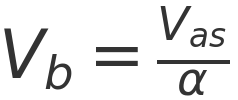Ready to dive in a little deeper?
The full formula for calculating ‘optimum box volume’ is:

Vas, Qts and fs are all known numbers, and are available from the TS Parameters published for the speaker driver you want to use. However to use the above formula, you need to determine fb which is the tuning frequency of the ports in the cabinet. Its generally considered that you get the best results by selecting a tuning frequency just slightly higher than fs – it gives the best combination of performance improvements. The aim of the ported cabinet is to extend the bass response, and enhance the lower bass output, getting the right cabinet volume and correct fb also helps maintain damping and give a smoother bass roll off, whilst at the same time controlling excursion at bass frequencies to prevent over-excursion. If you’ve read about fs you’ll already know this is the frequency that the woofer naturally moves easiest, if it moves too much, it will get damaged. The ports reduce the cone excursion around fb so its sensible to keep this near fs to keep the overall cone excursion under control.
At this stage we are just trying to work out an approximate target volume for the cabinet based on the desired tuning frequency. The final tuning frequency of the box, fb is determined by the port dimensions and length with respect to the box volume. We are not setting fb with the box volume, we’re just estimating a target box volume that’s suitable for the driver to get good results.
The above formula would prove useful if you are aiming to get a small compact cabinet with optimum damping, but sacrificing bass extension. If you have enough headroom to compensate with DSP, this would allow for some very compact designs, particularly if punchy bass is the target.
Assuming we are looking to achieve good bass extension, common in large format PA applications, it would be simpler to just use fs = fb to get a typical cabinet volume, this simplifies the equation to:

Our recommendation is that this would normally be a good target volume for good bass response, and you could adjust this according to your design objective. You don’t want to make it too large, as this will compromise damping, so perhaps up to 30% larger for deep bass. If you want a compact cabinet, 10%-15% smaller if you are willing to have some compromise on bass extension to minimise cabinet volume.
Here are some example calculations for a popular 18″ woofer:
- Vas = 212 litres
- Qts = 0.35
- fs = 34 Hz
Vb = 20 × 212 × (0.35)3.3 ≈ 132.7 litres
This gives a practical starting point for designing a PA bass reflex enclosure. It aligns closely with real-world cabinet sizes — allowing for bracing, port volume, and tuning flexibility — while remaining efficient and well-controlled for live sound applications. Remember this is the REMAINING volume after subtracting handles, ports, braces, and the volume of the driver itself. Your unloaded cabinet would probably need to be around 150 litres when designed.
To make the most compact cabinet, you could reduce this to 125 litres, and accept reduced low frequency extension, but potentially the ability to tune for tight punchy bass above fs
If you want more deep bass, and size isn’t an issue, a 200 litre cabinet would give more options for lower tuning, deeper bass, but most likely worse damping (sloppy or less responsive bass) and lower efficiency.
So you can see, cabinet volume can vary a lot, the driver will still work, but the results will also vary.

